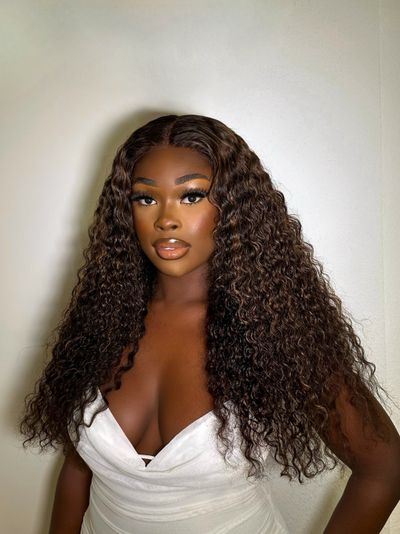Understanding difference between frontal and closure wig

Understanding the difference between frontal and closure wig options is crucial for anyone interested in wigs. The wig market has seen significant growth, with a projected valuation of USD 14.29 billion by 2032. Wigs have become increasingly popular in haircare and fashion, driven by rising disposable income and the desire for enhanced physical appearance. Many people now use wigs as a fashion accessory or to address hair-related issues. Brands like Luvmeforyou offer various choices, including the body wave closure wig, catering to diverse styling needs.
What is a Frontal Wig?

Definition and Overview
A frontal wig features a lace frontal installed across the front of the wig. This lace strip runs from ear to ear, measuring about 13 inches wide and covering four to six inches deep. The lace blends seamlessly with the natural skin and hairline, providing a realistic appearance. Transparent and HD lace options are popular choices for frontal wigs.
Coverage Area
Frontal wigs cover the entire front area of the head, extending from ear to ear. This extensive coverage mimics a natural hairline, making the wig look more realistic. The large lace portion requires more maintenance but offers a natural look.
Common Uses
Frontal wigs serve various purposes. Many people use them to conceal hair loss along the hairline. The ear-to-ear coverage allows for versatile styling options. Users can create deep side parts, half-up ponytails, full ponytails, and messy buns. Frontal wigs also provide an affordable alternative to full-lace wigs.
Pros and Cons
Advantages
Versatility: Frontal wigs allow for multiple styling options, including side parts, fishtail braids, and ponytails.
Natural Appearance: The lace blends with the skin, offering a realistic hairline.
Coverage: The wig covers the entire front area, making it ideal for those with thinning edges.
Customization: The lace can be customized to match different skin tones.
Disadvantages
Maintenance: The larger lace portion requires more upkeep compared to closure wigs.
Cost: Frontal wigs tend to be more expensive due to the extensive lace and hand-tied hair.
Installation: Installing a frontal wig can be more complex and time-consuming.
Durability: Frequent styling and maintenance can reduce the lifespan of the lace.
What is a Closure Wig?

Definition and Overview
A closure wig features a lace closure sewn into the wig. The lace closure sits at the front of the head, typically in the center. Hand-tied hair strands on the lace base create a natural-looking part. This design allows users to tuck away all natural hair under a wig cap. The body wave closure wig offers a voluminous and relaxed appearance, making it versatile for various styles.
Coverage Area
Closure wigs cover a smaller area compared to frontal wigs. The lace piece only covers the crown of the head. This smaller coverage area makes the wig easier to maintain. The body wave closure wig provides a natural look without extensive maintenance.
Common Uses
People often use closure wigs to finish off sew-ins and wigs with a realistic-looking part. These wigs are ideal for those new to wearing wigs. The easy installation process makes them a great choice for beginners. The body wave closure wig offers a subtle wave pattern, suitable for everyday wear and simple styles like middle parts.
Pros and Cons
Advantages
Ease of Use: Closure wigs are easier to install than frontal wigs.
Cost-Effective: These wigs are generally less expensive than frontal wigs.
Low Maintenance: The smaller lace area requires less upkeep.
Natural Look: The lace closure provides a realistic part without the need for blending.
Protection: Closure wigs protect natural hair while offering a stylish appearance.
Disadvantages
Limited Styling Options: Closure wigs offer fewer styling options compared to frontal wigs.
Smaller Coverage Area: The lace only covers the crown, not the entire front hairline.
Less Versatility: These wigs are best suited for simple, everyday looks.
Customization: Limited customization options compared to frontal wigs.
Durability: Frequent use may reduce the lifespan of the lace.
Comparative Analysis
Size and Coverage
Frontal Wig Size
Frontal wigs feature a lace piece that measures approximately 13 inches wide and 4 to 6 inches deep. This large lace portion covers the entire front hairline from ear to ear. The extensive coverage area allows for a natural-looking hairline and versatile styling options.
Closure Wig Size
Closure wigs have a smaller lace piece, typically measuring 4x4 inches. This lace part covers only the crown of the head. The smaller size makes closure wigs easier to maintain and install. The limited coverage area suits those seeking a simple, everyday look.
Versatility and Styling Options
Styling with Frontal Wigs
Frontal wigs offer numerous styling possibilities. Users can create side parts, fishtail braids, and ponytails. The ear-to-ear lace coverage allows for half-up ponytails, full ponytails, and messy buns. Frontal wigs provide a realistic hairline, making them ideal for those with thinning edges.
Styling with Closure Wigs
Closure wigs offer fewer styling options compared to frontal wigs. The smaller lace piece limits the ability to create diverse hairstyles. Users can achieve middle parts and simple styles. Closure wigs are best suited for everyday wear and straightforward looks.
Cost Considerations
Price Range for Frontal Wigs
Frontal wigs tend to be more expensive due to the larger lace area and the amount of hand-tied hair. The extensive lace portion requires more craftsmanship, which increases the cost. Frontal wigs provide enhanced styling versatility, justifying the higher price.
Price Range for Closure Wigs
Closure wigs are generally more cost-effective. The smaller lace piece and simpler construction reduce the overall cost. Closure wigs offer a realistic appearance without the need for extensive maintenance. The affordability makes closure wigs a popular choice for beginners and those on a budget.
Installation Process
Installing a Frontal Wig
Installing a frontal wig involves several steps. First, prepare the natural hair by braiding it into cornrows or securing it under a wig cap. This step ensures a flat surface for the wig. Next, apply a skin-safe adhesive along the hairline. The adhesive helps secure the lace to the skin. Allow the adhesive to become tacky before placing the wig.
Position the frontal wig on the head. Align the lace with the natural hairline. Press the lace into the adhesive, starting from the center and moving outward. Use a comb to smooth the lace and remove any air bubbles. Trim the excess lace carefully with scissors. Ensure the lace blends seamlessly with the skin.
Style the frontal wig as desired. The ear-to-ear lace allows for versatile hairstyles. Users can create side parts, ponytails, and braids. Maintenance involves regular cleaning and reapplication of adhesive. The larger lace portion requires more upkeep but offers a natural look.
Installing a Closure Wig
Installing a closure wig is simpler compared to a frontal wig. Begin by preparing the natural hair. Braid the hair into cornrows or secure it under a wig cap. This step provides a flat base for the wig. Place the closure wig on the head. Position the lace closure at the crown of the head.
Secure the lace closure with adhesive or sewing. Apply a small amount of adhesive along the edges of the lace. Press the lace into the adhesive and allow it to set. Alternatively, sew the lace closure to the cornrows for a more secure fit. Ensure the lace lies flat against the scalp.
Style the closure wig to achieve a natural look. The smaller lace area limits styling options. Users can create middle parts and simple hairstyles. Closure wigs require less maintenance due to the smaller lace portion. Regular cleaning and minimal adhesive reapplication keep the wig looking fresh.
Making the Right Choice
Factors to Consider
Personal Styling Preferences
Personal styling preferences play a significant role in choosing between frontal and closure wigs. Frontal wigs offer versatility for various hairstyles. Users can create side parts, ponytails, and braids. The ear-to-ear lace coverage provides a natural hairline. This makes frontal wigs ideal for those with thinning edges.
Closure wigs suit individuals who prefer simple styles. These wigs offer a natural-looking part without extensive maintenance. Middle parts and straightforward hairstyles work well with closure wigs. The smaller lace area makes closure wigs easier to manage.
Budget Constraints
Budget constraints also influence the decision between frontal and closure wigs. Frontal wigs tend to be more expensive. The larger lace area and hand-tied hair increase the cost. Frontal wigs provide enhanced styling options, justifying the higher price.
Closure wigs are generally more affordable. The smaller lace piece reduces the overall cost. Closure wigs offer a realistic appearance without breaking the bank. This affordability makes closure wigs a popular choice for beginners and budget-conscious individuals.
Understanding the key differences between frontal and closure wigs helps in making an informed decision. Frontal wigs offer versatility and a natural hairline, while closure wigs provide ease of use and affordability. Choosing the right wig depends on individual styling preferences and budget constraints. Exploring both options can lead to finding the perfect fit. Wigs symbolize choice and creativity, allowing individuals to express themselves in various ways. Embrace the opportunity to enhance appearance and confidence through the right wig selection.






















